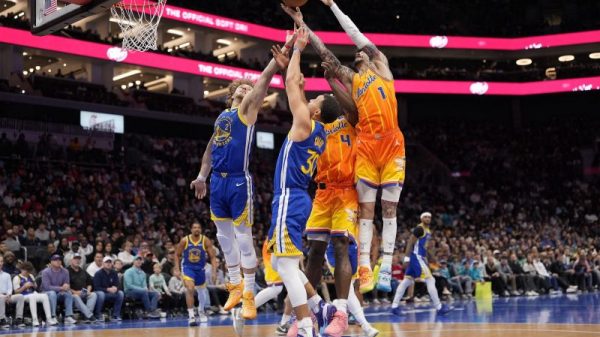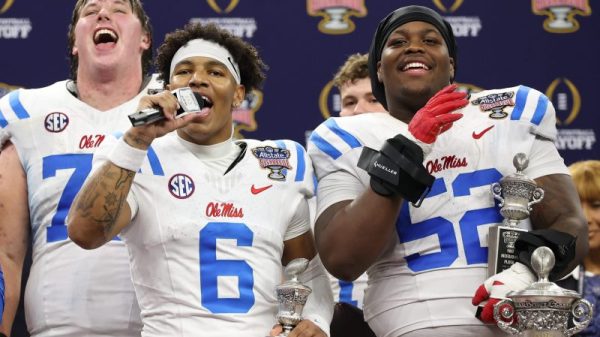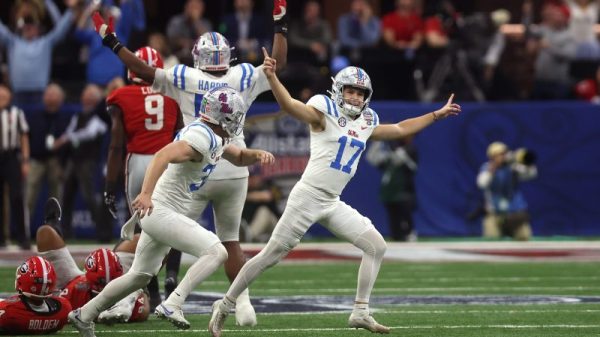NEW YORK — Chino Lopez, aka B-boy Action, took a page out of Wilt Chamberlain’s book. His breaking crew, the New York City Breakers, didn’t own a video camera in the beginning of 1984. But they owned a still camera and had a pen and paper.
‘We the New York City Breakers see the Olympic Games as our future,’ the message begins. ‘We see break dancing as a future Olympic sport, and ourselves as pioneers in making this dream a reality.’
Every member of the group signed the piece of paper. Lopez posed with it. Forty years later, as breaking is about to make its debut at the 2024 Paris Olympics, Lopez’s dream turns into reality – and brings an art form for kids trying to survive in the South Bronx to the biggest stage in international sports.
‘When people started breaking, it made people stop … and watch’
The Bronx burned around them in the projects. As kids, they were scared, said London Reyes, a member of the New York City Breakers during the group’s heyday of the 1980s.
2024 Olympic medals: Who is leading the medal count? Follow along as we track the medals for every sport.
‘You had crack, you had heroin, you had gangs that were running the streets, and they didn’t allow people to go from block to block,’ Reyes told USA TODAY Sports. ‘And when this dance started to be created, it demanded respect, attention.’
By now, the story of DJ Kool Herc elongating the breaks in the beat – hence the term breaking – long enough for people to drop to the floor and start dancing is well-chronicled, and the DJ born in Jamaica, who moved to the Bronx as a 12-year-old with his family in the late 1960s, was inducted into the Rock and Roll Hall of Fame in 2023. The breaks he invented became known as the ‘go off,’ a phrase that has found life generations after its origination.
For the racial minorities of the South Bronx, this became their life force.
‘We didn’t know why we were here,’ Reyes told USA TODAY Sports. ‘And so we did things to create attention, like ‘I’m somebody important. Look at me. I’m not a nobody. I’m a somebody.’ And that’s the importance of this art form.
‘When people started breaking, it made people stop what they were doing and watch.’
The burnt-down buildings became their playgrounds. They danced in basements, hallways, outside on the concrete. The best days were when they found cardboard to lay down. Reyes’ mother became legitimately concerned for her child when he removed all of the furniture from his bedroom to practice breaking. Watching him spin on his head made her even more worried.
‘We caught the attention of the media because they were looking at this like, ‘What is wrong with this kid?” Reyes said.
They listened to music from artists such as Baby Huey and Sly and the Family Stone and, of course, James Brown. To this day, ask a breaker what music he or she loves to dance to – the answer will likely involve Brown. That’s because of the drum beats from Brown’s drummer, Clyde Stubblefield.
The draw to ‘B-boy culture,’ Reyes said, was that it allowed a person to find out who they really were. They had to live it, dress it, breathe it, dance it.
‘There are some B-boys out there that don’t dress in the traditional B-boy style because they didn’t grow up in the seventies. So they’re not going to rock the hat like this necessarily,’ said Reyes, pointing to his cap with the bill slightly turned to the side. ‘But they might rock a stiletto, they might rock a beanie, they might rock a baseball cap twisted all the way around. They’re going to do something slightly different that fits their persona.’
And there was just something about the bravado from a Bronx B-boy – or B-girl. Even back then, breaking was for everybody.
As Reyes put it: ‘That, ‘Yeah, what up dog? What’s up baby?’ They fell in love with that person, that attitude like, ‘Yo, let’s go get him. Serve that dude.”
‘That little flavor, that little twist to it, that’s what made people say, ‘What are they doing?” Reyes said. ‘Just because you could do headspins and windmills doesn’t make you a B-boy. What makes you a B-boy is your persona. That persona has to transcend. And people have to feel that.’
Soon enough everybody knew what breaking was. It went from the Bronx to Manhattan and Brooklyn. From New York to Florida. From the U.S. to Mexico and Japan and Europe.
‘We came from the streets in Black and brown communities,’ said Sunny Choi, aka B-girl Sunny, who will represent the U.S. in Paris. ‘Breaking has really kind of globalized, and now we have this extremely, beautifully diverse world.’
Movies like ‘Breakin” and ‘Beat Street’ and ‘Style Wars’ popularized the dance. Crews such as the Breakers, Rock Steady Crew and Dynamic Rockers were earning invites from television programs. The New York City Breakers performed in front of President Ronald Reagan in 1984, and Lopez even challenged the United States men’s gymnastics team, which went on to win gold at the Los Angeles Games that summer, to a floor competition.
‘It was just everywhere,’ Reyes said. ‘You had toys, you had lunchboxes, posters.’
The New York City Breakers wanted to add a layer of professionalism to it all. But as hip-hop went mainstream, the thinking became that if a group looked like they could dance, they could be hired. Along the way, the culture was lost.
‘We were kids. We were still in school,’ Reyes said. ‘It wasn’t until the adults came in and ruined everything. That’s when the exploitation came in. That’s when it became more about the money and less about the craft.’
Eventually, people started speaking and singing over the break beats Herc had invented in the mid-1970s and other DJs had started making later in the decade. Rap music was born.
‘Now it dominates the music charts,’ Reyes said. ‘Again, right out of the South Bronx.’
Pioneers have mixed opinions on breaking as an Olympic sport
The early groups are referred to as the ‘OGs’ in the breaking world. The current generation idolizes them. The respect is real.
‘I get a lot of inspiration from the elders, from this dance,’ said U.S. Olympian Victor Montalvo, aka B-boy Victor.
They had names like Mr. Freeze, Frosty Freeze, Prince Ken Swift and Crazy Legs.
Not all ‘OGs’ are pleased that breaking is now an Olympic sport – or considered a sport at all.
‘I think some of ’em feel hurt,’ Reyes said. ‘Some of ’em feel like they got left behind. Some of ’em feel like they don’t have respect. Some of it is self-inflicted, and some of it is business.’
Reyes, who worked in Nike’s basketball entertainment division for more than a decade, speaks at high schools and universities occasionally. He’ll ask who has seen ‘Beat Street,’ for example. Not one hand goes in the air.
‘Because nobody was alive,’ Reyes said. ‘So we have to move on.’
The breaking world needs a new ‘Beat Street’ – and the ‘Step Up’ movies don’t count.
A lot of the OGs are not involved in the Olympic movement because they refuse to evolve, Reyes said. They want things to be the way it was in the 1970s and ’80s. But in this reality, Reyes added, everybody wins.
‘This is a beautiful thing, and I encourage the people to embrace it,’ he said. ‘It’s important. This is history in the making, and we’re not kids anymore, so let’s embellish it. Let’s live it. Let’s breathe it. Let’s enjoy it while we can, because we may not be around tomorrow.’
Breaking became more than an activity once Red Bull started sponsoring it. The first ‘Lords of the Floor’ competition in 2001 eventually turned into the popular BC One competition, the biggest international breaking showdown each year.
Breaking is not on the 2028 Los Angeles Games program. For it to be excluded in an Olympics hosted by the country it was born in gives Reyes mixed feelings.
‘It says that we’re still in the infant stage and we are still learning, right?’ Reyes said. ‘We’re learning the business part of it now. Because the truth is, you have to raise money. You need money to travel, to compete, to train, and we’re still behind on that.
‘Other countries are maybe a little ahead of us on that. So we have to regroup and we have to be honest with ourselves. We have to say, even though it started here, (it) doesn’t mean that we’re the gatekeepers.’
Legendary battles put breaking into pop culture and elevated its status
The competitive aspect to breaking has existed since its beginning in the form of ‘battles,’ the climaxes of those movies from the ’80s.
Battles took place at New York locations such as Poe Park or Cedar Park. Crews would take the subway to Orchard Beach. The beauty of breaking is that it could go down anytime, anywhere – even the Place de la Concorde in Paris at the 2024 Olympics.
‘We didn’t need anything. Just music. And music was free,’ Reyes said. ‘All you had to do (was) buy the batteries for the radio. That was it.’
The battles that will live on forever went down at New York City venues such as the Roxy Theater, Roseland Ballroom and Fun House. One of the most famous battles, Reyes said, was between the Rock Steady Crew and the Dynamic Rockers at the Lincoln Center in 1981. Rock Steady and The Floor Masters went at it at a place called The Grill in Manhattan. The Dynamic Rockers challenged The Floor Masters on a television show called ‘That’s Incredible!’ – the tape made its way to Mexico, where Victor Montalvo’s father paid one peso to watch the recording.
There’s also the battle that ended up airing in ‘Beat Street.’
‘That was a real battle,’ Reyes said. ‘It wasn’t like ‘Cut, makeup, please.’ It was just ‘let the cameras roll.’ Whatever happens, happens. Which is why ‘Beat Street’ is considered such a legendary movie.’
At the Olympics, competitors won’t go against one another in ‘crews.’ It’s one-on-one. But the spirit of breaking will be the same, Reyes said.
‘It started with predominantly Puerto Ricans and Blacks in the community, and you can trace it all the way back to the music from the rock dance,’ Reyes said.
Reyes has organized a youth competition called ‘Battle of the Boroughs’ for 25 years. The battles are, ideally, held quarterly but take place at least once per year.
‘We want to provide opportunity for all young people,’ Reyes said. ‘We want to build their character. We want to build their spirit. We want them to know that anything is possible.’
Calling it the ‘new lacrosse,’ Reyes has been petitioning school districts in Westchester County, immediately north of New York City, to make it an official sport.
His pitch is simple.
‘I said, ‘Did you know breaking was in the Olympics?” Reyes said.
The lack of expense and equipment appeals to administrators. All that is required is a shirt, floor space, maybe a hat or an elbow pad.
‘It is affordable and anybody can do it. You don’t have to be seven feet tall, you don’t have to bench 500 pounds,’ Reyes said. ‘All you have to do is be creative. And we’re all creative.’
Looking back, Reyes admits maybe the Breakers talked a big game with their Olympic-sized proclamation.
‘It wasn’t like it happened a week later,’ he said.
But Chino Lopez’s prediction, with photographic proof, eventually came to fruition.
‘This shows that we had this vision, that we really believed in this,’ Reyes said.
Reyes is thankful that he and his former crewmates are alive to see breaking reach the Olympics. He and Kid Nice and Icy Ice and Action are all excited to see their teenage dream come to life right before their own eyes.
‘Who would’ve ever thought?’ Reyes said. ‘I still can’t believe it.’
The USA TODAY app gets you to the heart of the news — fast.Download for award-winning coverage, crosswords, audio storytelling, the eNewspaper and more.



























